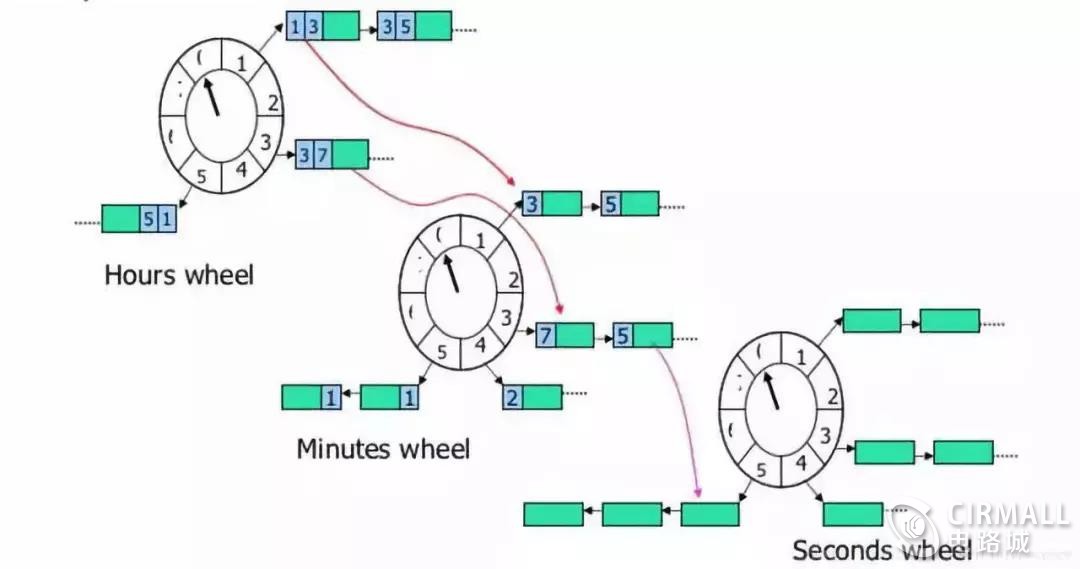TA的每日心情 | 无聊
2018-11-16 10:48 |
|---|
签到天数: 2 天 连续签到: 1 天 [LV.1]初来乍到
|
定时器的实现原理
定时器的实现依赖的是CPU时钟中断,时钟中断的精度就决定定时器精度的极限。一个时钟中断源如何实现多个定时器呢?对于内核,简单来说就是用特定的数据结构管理众多的定时器,在时钟中断处理中判断哪些定时器超时,然后执行超时处理动作。而用户空间程序不直接感知CPU时钟中断,通过感知内核的信号、IO事件、调度,间接依赖时钟中断。用软件来实现动态定时器常用数据结构有:时间轮、最小堆和红黑树。下面就是一些知名的实现:
Linux内核的 Hierarchy 时间轮算法Asio C++ Library最小堆定时器实现nginx 使用红黑树结构管理定时器事件
Linux内核定时器相关的一些相关代码:
内核启动注册时钟中断
// @file: arch/x86/kernel/time.c - Linux 4.9.7// 内核init阶段注册时钟中断处理函数static struct irqaction irq0 = { .handler = timer_interrupt, .flags = IRQF_NOBALANCING | IRQF_IRQPOLL | IRQF_TIMER, .name = "timer"};void __init setup_default_timer_irq(void){ if (!nr_legacy_irqs()) return; setup_irq(0, &irq0);}// Default timer interrupt handler for PIT/HPETstatic irqreturn_t timer_interrupt(int irq, void *dev_id){ // 调用体系架构无关的时钟处理流程 global_clock_event->event_handler(global_clock_event); return IRQ_HANDLED;}
内核时钟中断处理流程
// @file: kernel/time/timer.c - Linux 4.9.7/* * Called from the timer interrupt handler to charge one tick to the current * process. user_tick is 1 if the tick is user time, 0 for system. */void update_process_times(int user_tick){ struct task_struct *p = current; /* Note: this timer irq context must be accounted for as well. */ account_process_tick(p, user_tick); run_local_timers(); rcu_check_callbacks(user_tick);#ifdef CONFIG_IRQ_WORK if (in_irq()) irq_work_tick();#endif scheduler_tick(); run_posix_cpu_timers(p);}/* * Called by the local, per-CPU timer interrupt on SMP. */void run_local_timers(void){ struct timer_base *base = this_cpu_ptr(&timer_bases[BASE_STD]); hrtimer_run_queues(); /* Raise the softirq only if required. */ if (time_before(jiffies, base->clk)) { if (!IS_ENABLED(CONFIG_NO_HZ_COMMON) || !base->nohz_active) return; /* CPU is awake, so check the deferrable base. */ base++; if (time_before(jiffies, base->clk)) return; } raise_softirq(TIMER_SOFTIRQ); // 标记一个软中断去处理所有到期的定时器}
内核定时器时间轮算法
单层时间轮算法的原理比较简单:用一个数组表示时间轮,每个时钟周期,时间轮 current 往后走一个格,并处理挂在这个格子的定时器链表,如果超时则进行超时动作处理,然后删除定时器,没有则剩余轮数减一。原理如图:

Linux 内核则采用的是 Hierarchy 时间轮算法,Hierarchy 时间轮将单一的 bucket 数组分成了几个不同的数组,每个数组表示不同的时间精度,Linux 内核中用 jiffies 记录时间,jiffies记录了系统启动以来经过了多少tick。下面是一些代码:
// @file: kernel/time/timer.c - Linux 4.9.7/* * The timer wheel has LVL_DEPTH array levels. Each level provides an array of * LVL_SIZE buckets. Each level is driven by its own clock and therefor each * level has a different granularity. *//* Size of each clock level */#define LVL_BITS 6#define LVL_SIZE (1UL << LVL_BITS)/* Level depth */#if HZ > 100# define LVL_DEPTH 9# else# define LVL_DEPTH 8#endif#define WHEEL_SIZE (LVL_SIZE * LVL_DEPTH)struct timer_base { spinlock_t lock; struct timer_list *running_timer; unsigned long clk; unsigned long next_expiry; unsigned int cpu; bool migration_enabled; bool nohz_active; bool is_idle; DECLARE_BITMAP(pending_map, WHEEL_SIZE); struct hlist_head vectors[WHEEL_SIZE];} ____cacheline_aligned;
Hierarchy 时间轮的原理大致如下,下面是一个时分秒的Hierarchy时间轮,不同于Linux内核的实现,但原理类似。对于时分秒三级时间轮,每个时间轮都维护一个cursor,新建一个timer时,要挂在合适的格子,剩余轮数以及时间都要记录,到期判断超时并调整位置。原理图大致如下:

定时器的使用方法
在Linux 用户空间程序开发中,常用的定期器可以分为两类:
执行一次的单次定时器 single-short;循环执行的周期定时器 Repeating Timer;
其中,Repeating Timer 可以通过在Single-Shot Timer 终止之后,重新再注册到定时器系统里来实现。当一个进程需要使用大量定时器时,同样利用时间轮、最小堆或红黑树等结构来管理定时器。而时钟周期来源则需要借助系统调用,最终还是从时钟中断。Linux用户空间程序的定时器可用下面方法来实现:
通过alarm()或setitimer()系统调用,非阻塞异步,配合SIGALRM信号处理;通过select()或nanosleep()系统调用,阻塞调用,往往需要新建一个线程;通过timefd()调用,基于文件描述符,可以被用于 select/poll 的应用场景;通过RTC机制, 利用系统硬件提供的Real Time Clock机制, 计时非常精确;
上面方法没提sleep(),因为Linux中并没有系统调用sleep(),sleep()是在库函数中实现,是通过调用alarm()来设定报警时间,调用sigsuspend()将进程挂起在信号SIGALARM上,而且sleep()也只能精确到秒级上,精度不行。当使用阻塞调用作为定时周期来源时,可以单独启一个线程用来管理所有定时器,当定时器超时的时候,向业务线程发送定时器消息即可。
一个基于时间轮的定时器简单实现
#include <stdio.h>#include <signal.h>#include <stdlib.h>#include <unistd.h>#define TIME_WHEEL_SIZE 8typedef void (*func)(int data);struct timer_node { struct timer_node *next; int rotation; func proc; int data;};struct timer_wheel { struct timer_node *slot[TIME_WHEEL_SIZE]; int current;};struct timer_wheel timer = {{0}, 0};void tick(int signo){ // 使用二级指针删进行单链表的删除 struct timer_node **cur = &timer.slot[timer.current]; while (*cur) { struct timer_node *curr = *cur; if (curr->rotation > 0) { curr->rotation--; cur = &curr->next; } else { curr->proc(curr->data); *cur = curr->next; free(curr); } } timer.current = (timer.current + 1) % TIME_WHEEL_SIZE; alarm(1);}void add_timer(int len, func action){ int pos = (len + timer.current) % TIME_WHEEL_SIZE; struct timer_node *node = malloc(sizeof(struct timer_node)); // 插入到对应格子的链表头部即可, O(1)复杂度 node->next = timer.slot[pos]; timer.slot[pos] = node; node->rotation = len / TIME_WHEEL_SIZE; node->data = 0; node->proc = action;} // test case1: 1s循环定时器int g_sec = 0;void do_time1(int data){ printf("timer %s, %d\n", __FUNCTION__, g_sec++); add_timer(1, do_time1);}// test case2: 2s单次定时器void do_time2(int data){ printf("timer %s\n", __FUNCTION__);}// test case3: 9s循环定时器void do_time9(int data){ printf("timer %s\n", __FUNCTION__); add_timer(9, do_time9);}int main(){ signal(SIGALRM, tick); alarm(1); // 1s的周期心跳 // test add_timer(1, do_time1); add_timer(2, do_time2); add_timer(9, do_time9); while(1) pause(); return 0;}
在实际项目中,一个常用的做法是新起一个线程,专门管理定时器,定时来源使用rtc、select等比较精确的来源,定时器超时后向主要的work线程发消息即可,或者使用timefd接口。
|
|
 /2
/2 
 /2
/2 